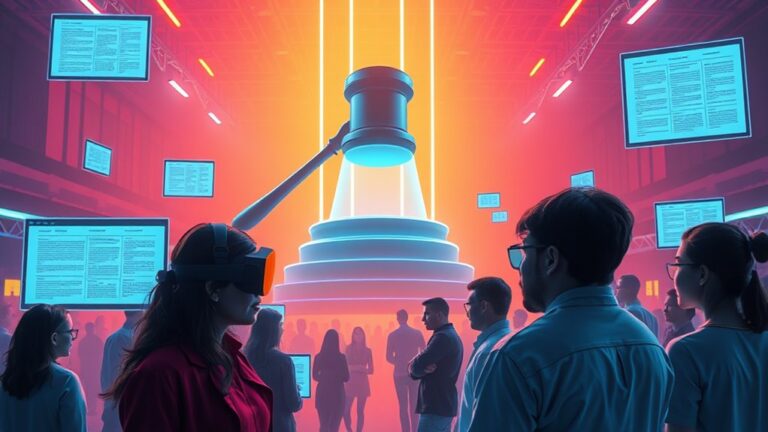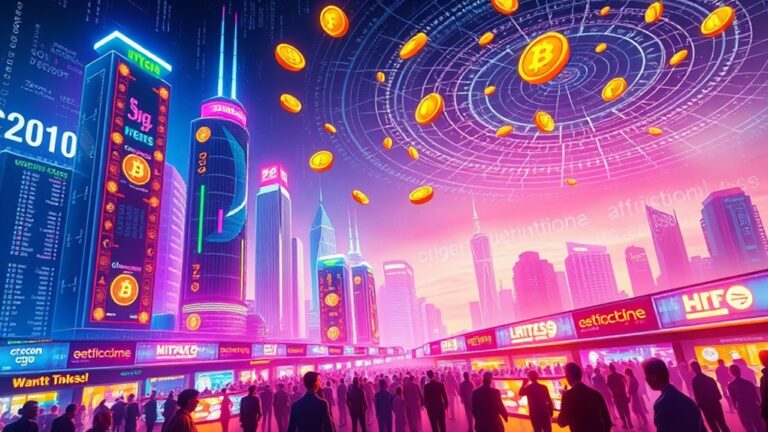
How Does Crypto Power the Metaverse: Unlocking Virtual Economies
Cryptocurrency powers the metaverse by providing a secure framework for virtual economies. It enables users to own and control digital assets without the need for intermediaries. This technology fosters efficient transactions, allowing for seamless transfers across platforms. Additionally, decentralized finance (DeFi) opens up new economic opportunities, eliminating traditional barriers to access. Native tokens serve as the medium for transactions and governance, ensuring user participation. Understanding these dynamics reveals more about the metaverse’s potential for growth and innovation.
Key Takeaways
- Cryptocurrencies enable secure, decentralized transactions, allowing users to buy, sell, and trade digital assets within the metaverse efficiently.
- Native tokens serve as the primary currency in virtual economies, facilitating governance, transactions, and interoperability across different platforms.
- Users maintain ownership and control over digital assets, enhancing their investment potential and fostering economic participation within virtual environments.
- Decentralized finance (DeFi) applications provide new financial services, including lending and earning passive income through crypto, reshaping traditional economic models.
- Cryptocurrency integration fosters seamless cross-platform transactions, promoting fluidity in virtual marketplaces and enhancing user experiences in the metaverse.
The Role of Blockchain Technology in the Metaverse
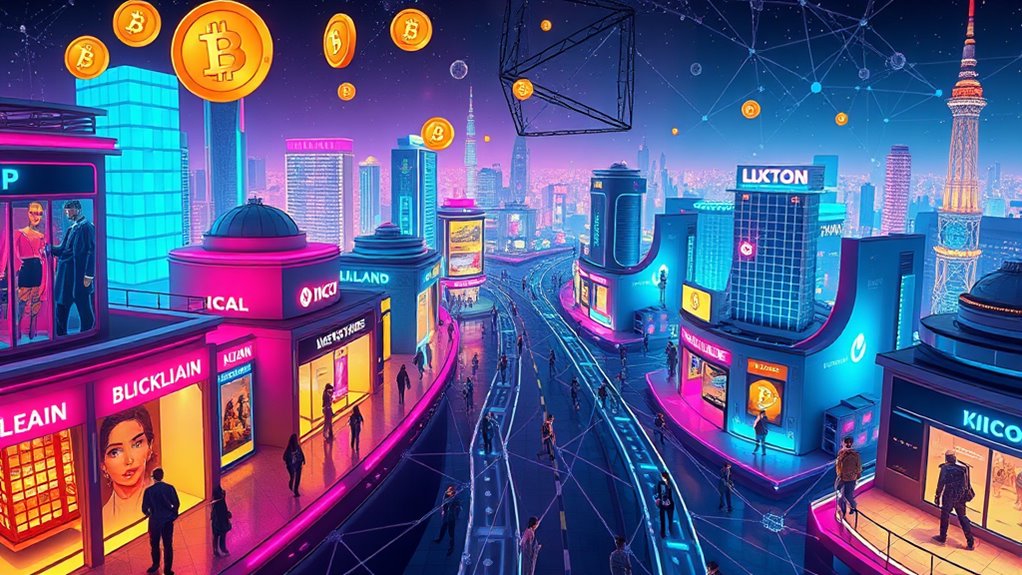
In the rapidly evolving landscape of the metaverse, blockchain technology plays an essential role by providing the foundational framework needed for its development.
By enabling decentralization, blockchain guarantees transparent and secure control, distributing data across a network of nodes. This technology securely manages data, creating an immutable ledger for transactions and virtual asset management.
Additionally, blockchain offers secure digital identity solutions, enhancing user privacy within virtual environments. Its interoperability features allow seamless movement between different metaverse platforms, while safeguarding ownership enhances immersive experiences. Moreover, the use of smart contracts enables automated and trustless transactions, further streamlining interactions within the metaverse.
As a result, blockchain not only supports the infrastructure of the metaverse but also enriches user interactions, creating a more secure and engaging digital landscape for all participants.
Cryptocurrency Integration and Virtual Asset Transactions

Cryptocurrency serves as an essential component in the integration of virtual asset transactions within the metaverse. It empowers users with greater ownership and control over digital assets, enabling secure transfers without intermediaries.
This decentralized transaction model fosters efficiency in virtual marketplaces, where the value of assets is influenced by market demand. Moreover, cryptocurrencies facilitate cross-platform transactions, enhancing fluidity across various metaverse environments.
The decentralized transaction model enhances efficiency in virtual marketplaces, driving asset value based on market demand and enabling seamless cross-platform interactions.
Users can monetize digital assets, bridging the gap between virtual and physical economies. Additionally, cryptocurrencies enable the creation and trading of non-fungible tokens (NFTs) for unique items and support virtual real estate transactions.
As the metaverse expands, it is expected to significantly impact the global economy, potentially contributing billions of dollars by 2030. Through these mechanisms, cryptocurrencies play a vital role in developing diverse, dynamic virtual economies that attract user engagement and participation.
Decentralized Finance: Expanding Economic Opportunities

Decentralized Finance (DeFi) is revolutionizing the way individuals engage in lending and borrowing by eliminating traditional intermediaries.
Platforms that facilitate tokenized asset trading are reshaping investment opportunities, allowing users to trade real-world assets in a digital format.
This shift not only enhances access to financial services but also promotes greater economic participation for individuals globally. Additionally, crypto lending allows users to earn passive income by offering their digital assets to borrowers, further contributing to the growth of these virtual economies.
Lending and Borrowing Platforms
Lending and borrowing platforms in the sphere of decentralized finance (DeFi) are transforming how individuals access financial services.
These platforms, such as Aave and Compound, utilize blockchain technology and smart contracts to facilitate peer-to-peer transactions without intermediaries. This approach reduces fees and enhances efficiency, allowing users to lend and borrow capital without traditional banking requirements.
DeFi lending democratizes access to funds by eliminating credit checks and enabling flexible interest rates based on market conditions. Additionally, users can earn higher interest rates compared to conventional savings accounts. Furthermore, these platforms are expected to dominate in 2025, offering investors insights into where they can earn passive income through crypto lending platforms.
However, participants should remain aware of risks like market volatility and over-collateralization. Overall, these platforms are pivotal in expanding economic opportunities within the metaverse.
Tokenized Asset Trading
The emergence of tokenized asset trading represents a significant advancement in the landscape of decentralized finance (DeFi), building upon the foundation laid by lending and borrowing platforms.
This process involves converting traditional assets into digital tokens on a blockchain, enhancing liquidity and broadening investment opportunities. Tokenization allows for fractional ownership, enabling more investors to access high-value assets such as real estate and art.
Decentralized exchanges (DEXs) facilitate peer-to-peer trading of these tokenized assets, ensuring secure and transparent transactions without intermediaries. Additionally, smart contracts automate ownership and transactions, reducing costs and enhancing security. Centralized exchanges, in contrast, hold custody of users’ assets, which exposes them to security vulnerabilities associated with hacking.
As traditional financial institutions adopt tokenization, the integration with DeFi protocols expands economic opportunities, paving the way for innovative financial products and services.
Navigating Investment Perspectives in the Metaverse

Steering investment perspectives in the metaverse requires an understanding of various opportunities and challenges.
Investors can explore options such as virtual real estate, digital assets, and companies developing augmented and virtual reality technologies.
However, it is essential to contemplate risks, including market volatility and the need for diversification strategies to manage potential losses effectively.
Investment Opportunities Overview
Investment opportunities within the metaverse are increasingly gaining attention as both individuals and institutions seek to capitalize on this emerging digital landscape.
Various strategies are available, including diversified ETFs like the Roundhill Ball Metaverse ETF, which offers exposure to multiple companies involved in metaverse development.
Virtual real estate presents another attractive option, as purchasing and developing digital land can yield returns akin to physical real estate.
Investors may also consider stocks in key companies such as Meta and Roblox, which are shaping the metaverse.
Additionally, specialized investment funds, like those targeting early-stage VR/AR companies, and blockchain-focused funds guarantee secure transactions, enhancing overall investment security and potential returns within this dynamic environment.
Risks and Challenges
As interest in the metaverse continues to grow, it is important for investors to recognize the various risks and challenges associated with this digital frontier.
Regulatory frameworks remain unclear, leading to potential legal complications and uncertainty regarding taxation on digital assets. Market volatility poses significant risks, as cryptocurrencies can experience drastic price fluctuations, while the success of the metaverse hinges on uncertain adoption rates.
Technological limitations, including hardware and software vulnerabilities, may impede user experience and security. Additionally, concerns about hacking and data breaches threaten user trust. Furthermore, the evolving regulatory landscape may influence investment strategies and the overall stability of virtual economies.
Collectively, these factors create a complex landscape for investors, necessitating careful consideration and a thorough understanding of the evolving dynamics within the metaverse.
Diversification Strategies Explained
Diversification strategies play an essential role in managing investment risks within the metaverse. By investing across various asset classes, investors can spread risk and potentially enhance returns. Key strategies include sector diversification, project diversification, and technology-driven diversification.
| Asset Class | Diversification Strategy |
|---|---|
| Virtual Real Estate | Mix of residential and commercial |
| Digital Assets | Include NFTs and cryptocurrencies |
| Metaverse Stocks | Focus on companies in gaming, socializing, and tech |
Investing in a mix of these options allows investors to capitalize on different market segments. As blockchain technology continues to evolve, it supports secure transactions and ownership, further enhancing the appeal of diversified investment strategies in the metaverse. Additionally, the rise of institutional adoption in cryptocurrencies is expected to provide greater stability and confidence in virtual economies.
Technological Innovations Enhancing User Experiences
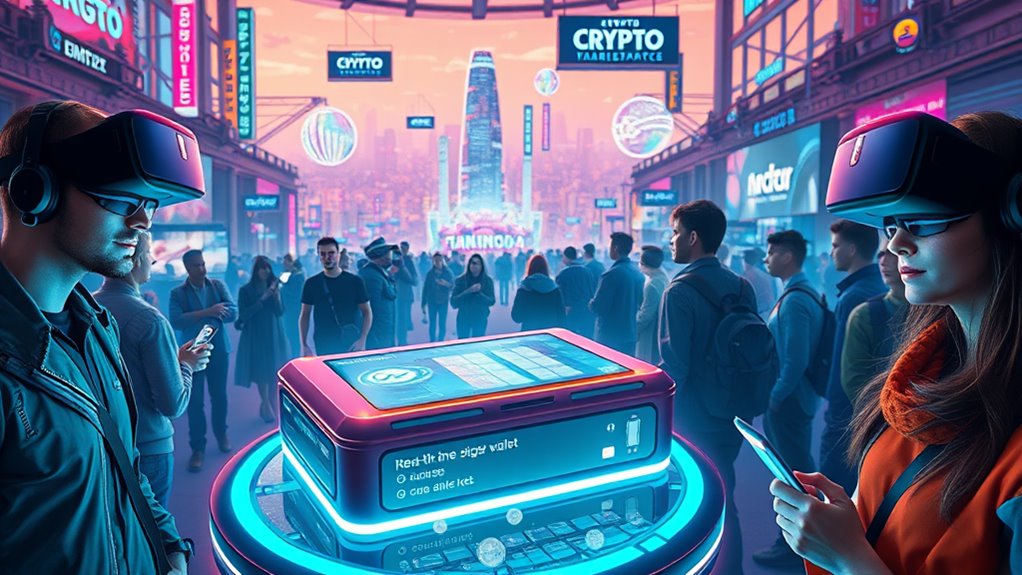
Technological innovations play a crucial role in enhancing user experiences within the digital domain. Advancements in virtual reality (VR) and augmented reality (AR) allow users to engage in immersive environments, fostering realistic interactions. Improved VR headsets and AR devices increase accessibility and elevate the quality of experiences.
Designers prioritize intuitive interactions through features like gesture recognition and voice commands, making navigation simpler. Additionally, realistic environments and sensory cues enhance user orientation. Haptic devices provide tactile feedback, enriching the sensory experience.
However, high-performance hardware is essential to overcome technical challenges and guarantee universal access. Overall, these innovations work together to create engaging and user-friendly experiences that draw individuals into the digital domain of the metaverse.
The Functionality of Native Tokens in Virtual Economies
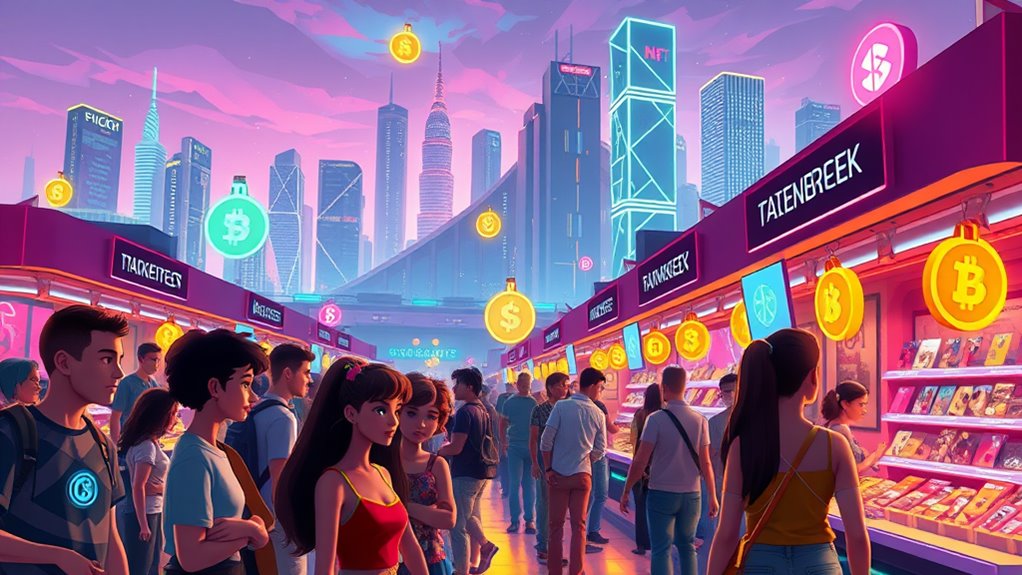
Native tokens serve a fundamental role in virtual economies, acting as the primary medium for transactions within digital environments. These tokens facilitate the purchase and sale of digital assets, enabling users to engage in economic activities.
Native tokens are crucial for virtual economies, enabling transactions and facilitating the trade of digital assets.
They also grant governance rights, allowing holders to influence decisions within platforms through decentralized models. In addition, some tokens support interoperability, enhancing user experience by allowing asset transfers across different virtual worlds.
Native tokens incentivize participation by rewarding users for engaging in activities, and their integration with blockchain technology guarantees secure and transparent transactions.
Moreover, they help establish clear ownership rights, create digital scarcity, and enable decentralized marketplaces, fostering a vibrant ecosystem for virtual asset trading. Additionally, the rise of decentralized finance has further bolstered the utility and adoption of native tokens in these virtual environments.
Future Outlook: Challenges and Growth Potential in the Metaverse
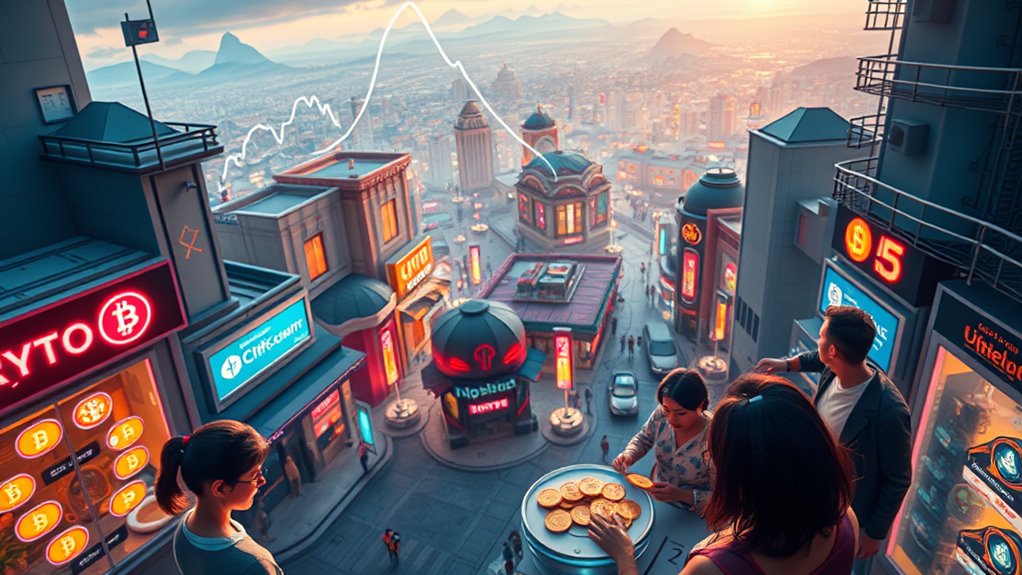
As the metaverse continues to evolve, the interplay between cryptocurrency and virtual economies presents both significant challenges and remarkable growth potential. The growth drivers include projections of a market value reaching between $800 billion and over $5 trillion by the early 2030s and advancements in technology enhancing user experiences. However, challenges such as security concerns, technological barriers, and regulatory uncertainties must be addressed for widespread adoption.
| Growth Drivers | Challenges |
|---|---|
| High market value projections | Security and privacy concerns |
| Technological advancements | Regulatory uncertainties |
| Multisectoral applications | High costs of hardware |
| Increased user adoption | Inaccessibility issues |
| Private and public investment | Scalability challenges |
The future of the metaverse is promising but requires careful navigation of its challenges.
Frequently Asked Questions
How Can Beginners Start Investing in Metaverse Cryptocurrencies?
Beginners can start investing in metaverse cryptocurrencies by opening a trading account, completing identity verification, funding their account, selecting specific cryptocurrencies like MANA or SAND, and placing buy orders on chosen exchanges.
What Are NFTS and How Do They Relate to Crypto?
Non-Fungible Tokens (NFTs) represent unique digital assets secured by blockchain technology. Unlike cryptocurrencies, NFTs are non-fungible, allowing ownership of distinct items, while their market value fluctuates based on demand and supply dynamics.
How Do Cryptocurrencies Facilitate Cross-Platform Interactions in the Metaverse?
Cryptocurrencies facilitate cross-platform interactions by providing secure ownership tracking, enabling seamless transactions between virtual worlds. Their decentralized nature allows peer-to-peer exchanges, while standardized protocols enhance interoperability, fostering collaboration and innovation across diverse metaverse environments.
What Security Measures Protect Crypto Transactions in Virtual Environments?
Over 80% of crypto users prioritize security measures. In virtual environments, robust encryption, decentralized networks, and multifactor authentication safeguard transactions, while regulatory frameworks guarantee compliance, protecting users against scams and enhancing overall trustworthiness.
How Do Regulatory Changes Impact Metaverse Cryptocurrencies and Investments?
Regulatory changes considerably influence metaverse cryptocurrencies and investments by establishing legal classifications, enhancing market transparency, and affecting compliance requirements. These factors ultimately shape investment opportunities, market stability, and innovation within the evolving digital landscape.
Conclusion
In summary, the intersection of cryptocurrency and the metaverse reveals a landscape rich with opportunities and challenges. As blockchain technology underpins virtual economies, the potential for decentralized finance and innovative user experiences continues to expand. However, traversing these emerging markets requires careful consideration of investment strategies and market dynamics. As the metaverse evolves, the synergy between crypto and virtual worlds will likely shape the future of digital interactions, presenting unforeseen possibilities for users and investors alike.




